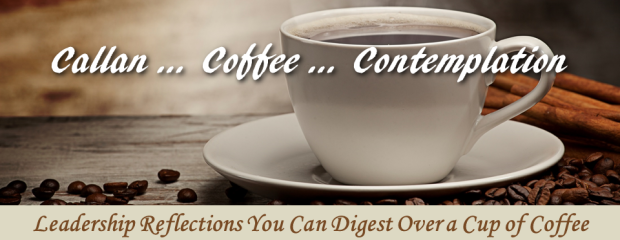Callan…Coffee…Contemplation for the Week of January 5th
What Do You See?
There are many ways one might distinguish heroic leaders from average leaders. Today, when reflecting on this question, this conclusion came to my mind: Where average leaders see mud, great leaders see gold. Heroic leadership does not ignore the brutal truth or the hard reality of our current condition (the mud); candor is necessary to be truly heroic. However, where the average leader becomes mired in the mud, emotionally and physically stuck, the heroic leader, through vision and conviction, sees how the mud can be transformed into gold. In my life, and the many times I have been in the mud, I recognize now the very real truth of the following sage wisdom: Wherever one falls, there lies your teacher. The mud exists and frustrates us, yes; but the mud also contains within it the opportunity for a breakthrough, and a break out. The mud exists to teach us something, as individuals and groups, we desperately need to learn. So yes, where average leaders see mud, great leaders see gold. The opportunity lies within the problem; the difference is how we see it. So, what do you see—mud or gold?
Between
In a recent leadership seminar I was asked this question: “What is the time when a leader develops most, before or after a challenging assignment?” My answer was: Between. It is between starting and finishing, between success and failure, between joy and sorrow, between high and low–where a leader’s greatest growth and transformation occurs. When we are between we are most challenged, our character put to the test, and our true Self exposed. “Before” is important as a time of readiness and preparation, and “after” is important as a time of reflection and garnering lessons learned. However, it is when leaders are between the rock of certainty and the hard place of doubt when the pressure of tension tests us most. If we are wise, we allow this pressure to convert and strengthen us.
Fighting Spirit
I write frequently about fortitude, resilience, and grit. Why? Because a fighting spirit is essential for building championship cultures and is inherent to heroic ambition. As I learned as a US Marine, there is no better friend or fiercer competitor than one imbued with a fighting spirit. I use the term fighting spirit in its classic form; reflective more of attitude than a necessarily physical application. Leaders possessing a fighting spirit are tenacious, highly optimistic, hardy, and able to face tough situations with alacrity and courage. But make no mistake, a fighting spirit does not emerge naturally; it must be intentionally cultivated in our self and our teams through constant preparation and rehearsal. A fighting spirit does not deny we are surrounded by challenge and risk; it sees the hard truth. But it inspires us to take this right action: Attack in a different direction until we find a way to succeed!
Check back next Monday for a round up of this week’s social media shares. Or check us out on Facebook, Twitter, Google+, or Pinterest to see our posts every day!
Tweet Share






